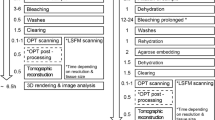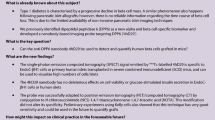Abstract
Purpose
The aim was to evaluate FDG PET imaging in Ela1-myc mice, a pancreatic cancer model resulting in the development of tumours with either acinar or mixed acinar-ductal phenotype.
Methods
Transversal and longitudinal FDG PET studies were conducted; selected tissue samples were subjected to autoradiography and ex vivo organ counting. Glucose transporter and hexokinase mRNA expression was analysed by quantitative reverse transcription polymerase chain reaction (RT-PCR); Glut2 expression was analysed by immunohistochemistry.
Results
Transversal studies showed that mixed acinar-ductal tumours could be identified by FDG PET several weeks before they could be detected by hand palpation. Longitudinal studies revealed that ductal—but not acinar—tumours could be detected by FDG PET. Autoradiographic analysis confirmed that tumour areas with ductal differentiation incorporated more FDG than areas displaying acinar differentiation. Ex vivo radioactivity measurements showed that tumours of solely acinar phenotype incorporated more FDG than pancreata of non-transgenic littermates despite the fact that they did not yield positive PET images. To gain insight into the biological basis of the differential FDG uptake, glucose transporter and hexokinase transcript expression was studied in microdissected tumour areas enriched for acinar or ductal cells and validated using cell-specific markers. Glut2 and hexokinase I and II mRNA levels were up to 20-fold higher in ductal than in acinar tumours. Besides, Glut2 protein overexpression was found in ductal neoplastic cells but not in the surrounding stroma.
Conclusion
In Ela1-myc mice, ductal tumours incorporate significantly more FDG than acinar tumours. This difference likely results from differential expression of Glut2 and hexokinases. These findings reveal previously unreported biological differences between acinar and ductal pancreatic tumours.





Similar content being viewed by others
References
DiMagno EP, Reber HA, Tempero MA. AGA technical review on the epidemiology, diagnosis, and treatment of pancreatic ductal adenocarcinoma. American Gastroenterological Association. Gastroenterology 1999;117:1464–84.
Real FX. A “catastrophic hypothesis” for pancreas cancer progression. Gastroenterology 2003;124:1958–64.
Chin BB, Chang PP. Gastrointestinal malignancies evaluated with (18)F-fluoro-2-deoxyglucose positron emission tomography. Best Pract Res Clin Gastroenterol 2006;20:3–21.
Delbeke D, Pinson CW. Pancreatic tumors: role of imaging in the diagnosis, staging, and treatment. J Hepatobiliary Pancreat Surg 2004;11:4–10.
Aguilar S, Corominas JM, Malats N, Pereira JA, Dufresne M, Real FX, et al. Tissue plasminogen activator in murine exocrine pancreas cancer: selective expression in ductal tumors and contribution to cancer progression. Am J Pathol 2004;165:1129–39.
Sandgren EP, Quaife CJ, Paulovich AG, Palmiter RD, Brinster RL. Pancreatic tumor pathogenesis reflects the causative genetic lesion. Proc Natl Acad Sci USA 1991;88:93–7.
Liao DJ, Wang Y, Wu J, Adsay NV, Grignon D, Khanani F, et al. Characterization of pancreatic lesions from MT-tgf alpha, Ela-myc and MT-tgf alpha/Ela-myc single and double transgenic mice. J Carcinog 2006;5:19.
Thorens B. Molecular and cellular physiology of Glut-2, a high-Km facilitated diffusion glucose transporter. Int Rev Cytol 1992;137:209–38.
Smith TAD. The rate-limiting step for tumor [18F]fluoro-2-deoxy-D-glucose (FDG) incorporation. Nucl Med Biol 2001;28:1–4.
Hernández-Muñoz I, Skoudy A, Real FX, Navarro P. Pancreatic ductal adenocarcinoma: cellular origin, signaling pathways and stroma contribution. Pancreatology 2008;8:462–9.
Pauwels EK, Ribeiro MJ, Stoot JH, McCready VR, Bourguignon M, Mazière B. FDG accumulation and tumor biology. Nucl Med Biol 1998;25:317–22.
Macheda ML, Rogers S, Best JD. Molecular and cellular regulation of glucose transporter (Glut) proteins in cancer. J Cell Physiol 2005;202:654–62.
Smith TA. Mammalian hexokinases and their abnormal expression in cancer. Br J Biomed Sci 2000;57:170–8.
Nakata B, Nishimura S, Ishikawa T, Ohira M, Nishino H, Kawabe J, et al. Prognostic predictive value of 18F-fluorodeoxyglucose positron emission tomography for patients with pancreatic cancer. Int J Oncol 2001;19:53–8.
Zimny M, Fass J, Bares R, Cremerius U, Sabri O, Buechin P, et al. Fluorodeoxyglucose positron emission tomography and the prognosis of pancreatic carcinoma. Scand J Gastroenterol 2000;35:883–8.
Seitz U, Wagner M, Vogg AT, Glatting G, Neumaier B, Greten FR, et al. In vivo evaluation of 5-[(18)F]fluoro-2′-deoxyuridine as tracer for positron emission tomography in a murine pancreatic cancer model. Cancer Res 2001;61:3853–7.
Buck AC, Schirrmeister HH, Guhlmann CA, Diederichs CG, Shen C, Buchmann I, et al. Ki-67 immunostaining in pancreatic cancer and chronic active pancreatitis: does in vivo FDG uptake correlate with proliferative activity? J Nucl Med 2001;42:721–5.
Guerra C, Schuhmacher AJ, Canamero M, Grippo PJ, Verdaguer L, Perez-Gallego L, et al. Chronic pancreatitis is essential for induction of pancreatic ductal adenocarcinoma by K-Ras oncogenes in adult mice. Cancer Cell 2007;11:291–302.
Knoess C, Siegel S, Smith A, Newport D, Richerzhagen N, Winkeler A, et al. Performance evaluation of the microPET R4 PET scanner for rodents. Eur J Nucl Med Mol Imaging 2003;30:737–47.
Phelps ME, editor. PET molecular imaging and its biological applications. New York: Springer; 2004.
van Kouwen MC, Laverman P, van Krieken JH, Oyen WJ, Jansen JB, Drenth JP. FDG-PET in the detection of early pancreatic cancer in a BOP hamster model. Nucl Med Biol 2005;32:445–50.
Higashi T, Tamaki N, Torizuka T, Nakamoto Y, Sakahara H, Kimura T, et al. FDG uptake, Glut-1 glucose transporter and cellularity in human pancreatic tumors. J Nucl Med 1998;39:1727–35.
von Forstner C, Egberts JH, Ammerpohl O, Niedzielska D, Buchert R, Mikecz P, et al. Gene expression patterns and tumor uptake of 18F-FDG, 18F-FLT, and 18F-FEC in PET/MRI of an orthotopic mouse xenotransplantation model of pancreatic cancer. J Nucl Med 2008;49:1362–70.
Bos R, van Der Hoeven JJ, van Der Wall E, van Der Groep P, van Diest PJ, Comans EF, et al. Biologic correlates of (18)fluorodeoxyglucose uptake in human breast cancer measured by positron emission tomography. J Clin Oncol 2002;20:379–87.
Hooft L, van der Veldt AA, van Diest PJ, Hoekstra OS, Berkhof J, Teule GJ, et al. [18F]fluorodeoxyglucose uptake in recurrent thyroid cancer is related to hexokinase i expression in the primary tumor. J Clin Endocrinol Metab 2005;90:328–34.
Natsuizaka M, Ozasa M, Darmanin S, Miyamoto M, Kondo S, Kamada S, et al. Synergistic up-regulation of Hexokinase-2, glucose transporters and angiogenic factors in pancreatic cancer cells by glucose deprivation and hypoxia. Exp Cell Res 2007;313:3337–48.
Yoon DY, Buchler P, Saarikoski ST, Hines OJ, Reber HA, Hankinson O. Identification of genes differentially induced by hypoxia in pancreatic cancer cells. Biochem Biophys Res Commun 2001;288:882–6.
Mikuriya K, Kuramitsu Y, Ryozawa S, Fujimoto M, Mori S, Oka M, et al. Expression of glycolytic enzymes is increased in pancreatic cancerous tissues as evidenced by proteomic profiling by two-dimensional electrophoresis and liquid chromatography-mass spectrometry/mass spectrometry. Int J Oncol 2007;30:849–55.
Hingorani SR. New pathways to pancreatic cancer. Cancer Biol Ther 2004;3:170–2.
Schmid RM. Genetic basis of pancreatic cancer. Best Pract Res Clin Gastroenterol 2002;16:421–33.
Tuveson DA, Hingorani SR. Ductal pancreatic cancer in humans and mice. Cold Spring Harb Symp Quant Biol 2005;70:65–72.
Hingorani SR, Petricoin EF, Maitra A, Rajapakse V, King C, Jacobetz MA, et al. Preinvasive and invasive ductal pancreatic cancer and its early detection in the mouse. Cancer Cell 2003;4:437–50.
Nitzsche EU, Hoegerle S, Mix M, Brink I, Otte A, Moser E, et al. Non-invasive differentiation of pancreatic lesions: is analysis of FDG kinetics superior to semiquantitative uptake value analysis? Eur J Nucl Med Mol Imaging 2002;29:237–42.
Real FX, Cibrián-Uhalte E, Martinelli P. Pancreatic cancer development and progression: remodeling the model. Gastroenterology 2008;135:724–8.
Acknowledgements
We are very grateful to Dr. Eric P. Sandgren for providing Ela1-myc mice and Dr. Chaitanya R. Divgi for critical reading of the manuscript. We also thank S. Mancilla, T. Lobato and A. Doutres for technical support and the personnel of the Radiochemistry Laboratory of IAT for FDG manufacture. This study was partially supported by the RTICC (Instituto de Salud Carlos III) and by grants from Plan Nacional de I + D, Ministerio de Educación y Ciencia (SAF2005-00704), Fundació La Marató TV3 (grant 051110) and Generalitat de Catalunya (2005SGR00729) to PN and from Plan Nacional de I + D, Ministerio de Educación y Ciencia (SAF2004-01137) and VIth Framework WU Programme (Biomed Programme (LSHB-CT-2006-018771 MOLDIAG-PaCa) to FXR. IA was partially supported by a postdoctoral fellowship from the Basque Government.
Author information
Authors and Affiliations
Corresponding author
Rights and permissions
About this article
Cite this article
Abasolo, I., Pujal, J., Rabanal, R.M. et al. FDG PET imaging of Ela1-myc mice reveals major biological differences between pancreatic acinar and ductal tumours. Eur J Nucl Med Mol Imaging 36, 1156–1166 (2009). https://doi.org/10.1007/s00259-009-1083-3
Received:
Accepted:
Published:
Issue Date:
DOI: https://doi.org/10.1007/s00259-009-1083-3




